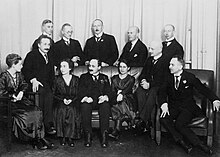Walter Grotrian
Appearance

Walter Robert Wilhelm Grotrian (21 April 1890 in Aachen; † 3 March 1954 in Potsdam) was a German astronomer and astrophysicist.
Grotrian studied the emission line from the solar corona in the green region of the spectrum; this emission line could not be attributed to any known chemical element and was thought to be a new element (which scientists named "coronium"). Grotrian and Bengt Edlén from Sweden demonstrated that the two observed emission lines arise from iron atoms that have lost about half their 26 electrons.ESO. The Glory of a Nearby Star
Named after Grotrian
- The impact crater Grotrian on the Moon
- The Grotrian diagram in atomic spectroscopy showing the allowed transitions between atomic energy levels
- Character in "Time Keeps on Slippin'" episode of Futurama
